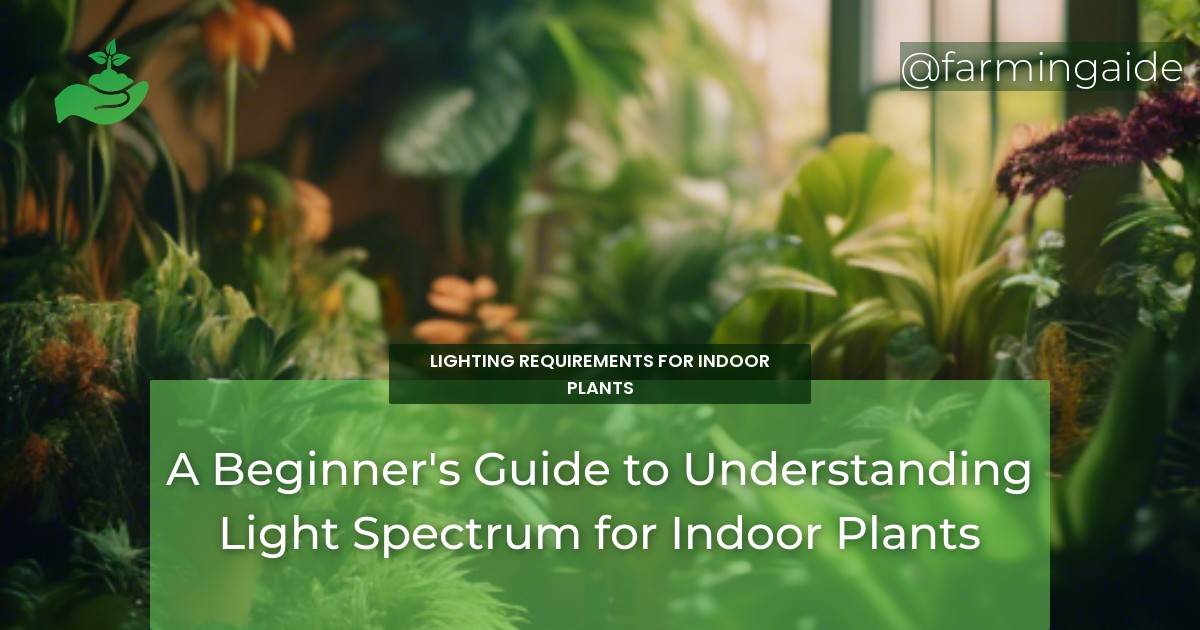As an indoor gardener, you understand the importance of providing your plants with the right conditions to thrive. While many of us focus on watering, fertilizing, and pruning, there’s another crucial factor that often gets overlooked: light spectrum. Yes, you read that right – light spectrum! The type of light your plants receive can greatly impact their growth, development, and overall health. In this comprehensive guide, we’ll delve into the world of light spectrum for indoor plants, exploring what it is, why it matters, and how to choose the right spectrum for your green friends.
Key Takeaways
- Light spectrum affects plant growth, development, and health.
- Different light spectrums have distinct effects on plants.
- Choosing the right light spectrum depends on plant type and growth stage.
- Grow lights can be tailored to specific light spectrums.
- Understanding light spectrum can help troubleshoot common plant issues.
Introduction to Light Spectrum for Indoor Plants
Light spectrum refers to the range of electromagnetic radiation emitted by a light source, including visible, ultraviolet (UV), and infrared (IR) radiation. In the context of indoor plants, light spectrum plays a critical role in regulating various physiological processes, such as photosynthesis, growth, and development. Think of it like this: different light spectrums are like different languages, and plants respond accordingly.
What is Light Spectrum?
In simple terms, light spectrum is the distribution of light energy across different wavelengths. The visible spectrum, which spans from approximately 400 to 700 nanometers (nm), includes the colors of the rainbow: violet, blue, green, yellow, orange, and red. Plants respond to specific ranges within this spectrum, which is where the magic happens.
Importance of Light Spectrum for Plant Growth
Light spectrum influences plant growth, development, and health in several ways:
- Photosynthesis: Light energy drives photosynthetic reactions, producing energy-rich molecules.
- Hormone regulation: Light spectrum affects hormone production, influencing growth patterns and flowering.
- Cell elongation: Light spectrum influences cell growth and expansion.
- Pigmentation: Light spectrum affects the production of pigments, such as chlorophyll and carotenoids.
Understanding Different Light Spectrums
Different light spectrums have distinct effects on plants. Let’s explore three primary spectrums and their effects on indoor plants:
ALSO READ
Blue Spectrum: The Growth Stimulator
Blue light, ranging from 450 to 495 nm, promotes:
- Vegetative growth: Stimulates leaf growth and development.
- Root growth: Encourages root development and nutrient uptake.
- Cell division: Boosts cell division and expansion.
Red Spectrum: The Flowering Inducer
Red light, ranging from 650 to 750 nm, triggers:
- Flowering and fruiting: Stimulates reproductive growth and flowering.
- Hormone regulation: Influences hormone production, promoting flowering and seed production.
- Senescence: Regulates leaf senescence, promoting healthy leaf growth.
ALSO READ
Full Spectrum: The All-Rounder
Full-spectrum lighting, which includes the entire visible spectrum, provides a balanced growth environment, supporting:
- Overall growth: Supports healthy growth, development, and flowering.
- Pigmentation: Enhances coloration and pigment production.
- Root growth: Promotes healthy root development.
Choosing the Right Light Spectrum for Your Plants
When selecting a light spectrum for your indoor plants, consider the following factors:
Factors to Consider When Choosing Light Spectrum
- Plant type: Different plants respond to specific light spectrums.
- Growth stage: Seedlings, vegetative growth, and flowering require distinct light spectrums.
- Environmental conditions: Consider temperature, humidity, and CO2 levels.
Common Indoor Plants and Their Preferred Light Spectrum
| Plant Type | Preferred Light Spectrum |
|---|---|
| Tomatoes | Red spectrum (650-750 nm) |
| Leafy Greens | Blue spectrum (450-495 nm) |
| Orchids | Full spectrum (400-700 nm) |
Implementing Light Spectrum in Your Indoor Garden
Now that you understand the importance of light spectrum, it’s time to put it into practice. Here are some tips for implementing the right light spectrum in your indoor garden:
Types of Grow Lights and Their Spectrum
- LED grow lights: Offer specific spectrums (e.g., blue, red, or full spectrum).
- Fluorescent grow lights: Provide a balanced, full-spectrum output.
- HPS (High-Pressure Sodium) grow lights: Emphasize the red spectrum.
Setting Up Grow Lights for Optimal Plant Growth
When setting up your grow lights, consider:
- Distance: Maintain a suitable distance between the light source and plants.
- Intensity: Adjust light intensity based on plant type and growth stage.
- Duration: Provide the recommended photoperiod for your plants.
Troubleshooting Common Issues Related to Light Spectrum
If you’re experiencing issues with your indoor plants, it might be related to the light spectrum. Here’s how to troubleshoot:
Signs of Inadequate Light Spectrum
- Stunted growth or stretching.
- Pale or yellowing leaves.
- Poor flowering or fruiting.
Adjusting Light Spectrum to Address Plant Issues
Identify the issue and adjust the light spectrum accordingly:
- Stunted growth: Increase blue light intensity or duration.
- Pale leaves: Provide more red light or increase overall intensity.
- Poor flowering: Increase red light duration or intensity.
Conclusion and Final Thoughts on Light Spectrum for Indoor Plants
In conclusion, understanding light spectrum is crucial for optimal plant growth and health. By recognizing the importance of different light spectrums and choosing the right one for your plants, you’ll be well on your way to creating a thriving indoor garden. Remember to consider plant type, growth stage, and environmental conditions when selecting a light spectrum, and don’t hesitate to adjust as needed. Happy growing!


